Kayak Under Mangrove Canopies, Spot Monkeys, and Ride Horses Along the Beach During This Central American Cruise
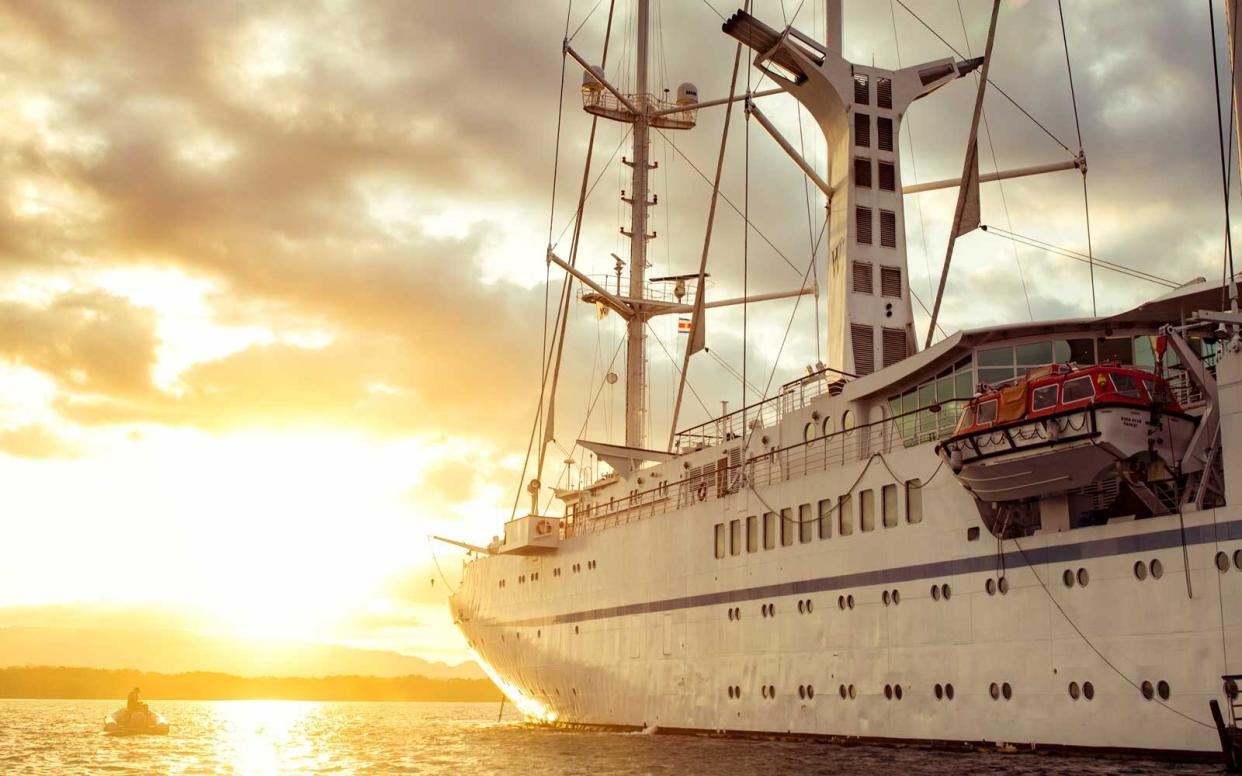
Gabriela Herman The Wind Star, a four-masted sailing yacht, off Puerto Jiménez in southern Costa Rica.
On a vivid day in early March, I am paddling a kayak through a rising tide on the Golfo Dulce, the body of water that runs along the remote Osa Peninsula in southwestern Costa Rica. Before me is the mouth of the Río Platanares. The air is 93 degrees, but the heat is cut by a light breeze. Cicadas whir in surround sound over a gentle chorus of wind-rustled palm fronds and small waves. An osprey sails overhead, then a blue heron, then a pair of white herons.
I'm with a group of fellow passengers from the Wind Star, a four-masted sailing yacht owned and operated by Windstar Cruises. We enter the Platanares, which soon narrows until it is hardly wider than my paddle, forcing us into a single-file line. Everyone falls silent as we glide beneath the delicious shade of the mangrove canopy. Here and there, I'm forced to duck under a low-hanging tendril.

Gabriela Herman Kayaking through mangroves on the Río Platanares, in Costa Rica.
Like a lot of people who go on cruises, I had come on this one because I needed a break. Work had been harrowing, and I hadn't been on a vacation in more than two years. I yearned for the sort of spiritual replenishment only genuine adventure can provide—and that's what Windstar's 10-day itinerary promised. The route runs through the Panama Canal and up the Pacific coast of Panama and Costa Rica, with stops in ports of call I'd never heard of: Golfito, Puerto Jiménez, Bahía Drake, Quepos, Bahía Herradura. It's a style of cruise that has been on the rise, as more passengers seek active, boundary-pushing experiences and see ships as a means to access remote places.
As we move along the Río Platanares, I drift to the rear of the pack, resting my paddle across my boat until the others are out of sight. I just sit and float, absorbing the immensity of the quiet. A white ibis stands on stiltlike legs. A mangrove hummingbird scoots along the river's surface. The exposed roots of the mangrove trees are kinked and curled above the waterline like bony limbs stuck in the mud. Beams of sunlight cut through their branches.
I catch up with the group just as Diego Vasquez, our naturalist-guide, spots a low-flying camelback hawk. He explains the role every animal plays in the ecosystem, from the mangrove crabs to the raccoons that eat them. Karen Birnbaum, a Brooklynite living in Toronto, keeps whispering, "Oh my God. This is unbelievable." Diego asks, "How do you like my office?"
We stop during the return paddle to pull our kayaks through the shallows and onto the riverbank. Over a small hill is a stretch of pristine beach with a view of what Diego tells us are Pavones Bay and the green hills of Zancudo. I take a long swim. As I towel off, Diego hands me wedges of fresh pineapple on top of a big slice of pineapple skin. I eat the sweet fruit and then squeeze the nectar from the pulpy skin until juice runs down my chin.
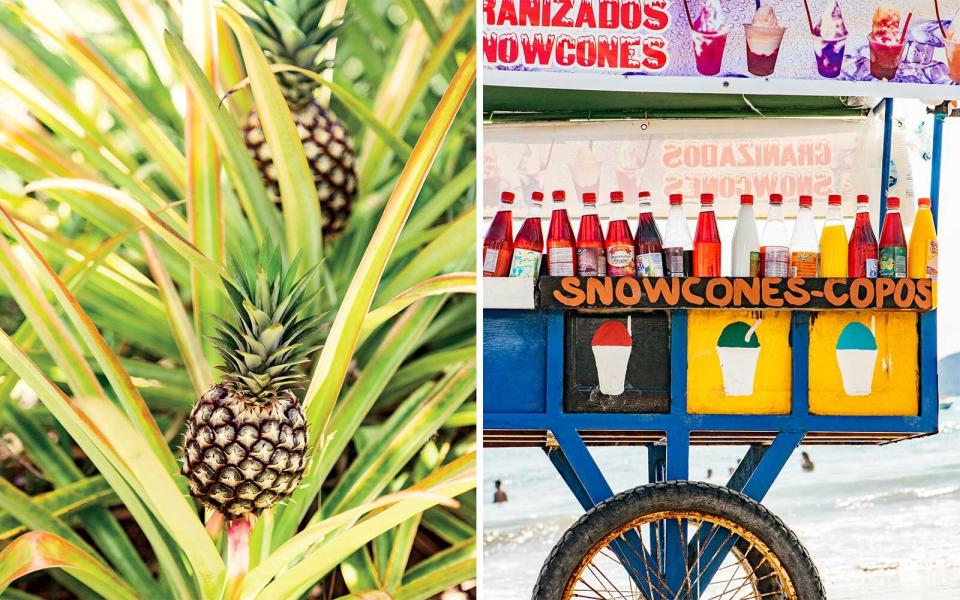
Gabriela Herman From left: A pineapple from Finca Kobo, a lodge and farm near Puerto Jiménez; a snow cone cart on Manuel Antonio Beach, in Costa Rica.
If you were asked to imagine the perfect vessel for venturing into unexplored pockets of the world, the Wind Star is precisely the sort of ship you'd come up with. A slick, gleaming-white, 440-foot yacht, it can carry 148 guests and 101 crew. With all four sails unfurled and the push of prevailing winds, it can barrel along at 14 knots. The captain is named Belinda Bennett, and she is the first black woman ever to captain a cruise ship. Captain Bennett grew up on St. Helena, a tiny island in the South Atlantic. St. Helena is the place on earth that is furthest from any other place on earth. At 17, Bennett took her first job, on a supply ship, the RMS St. Helena. Then she worked on a yacht off the shores of Monaco. Then for a ferry company servicing the Isle of Man. "I had goals in life, which I've succeeded at, and I'm a very strong woman," she says. "Being a woman, you have to work extra hard to prove yourself—even more than a man. I'm driven. I wanted to be captain, and so I am."
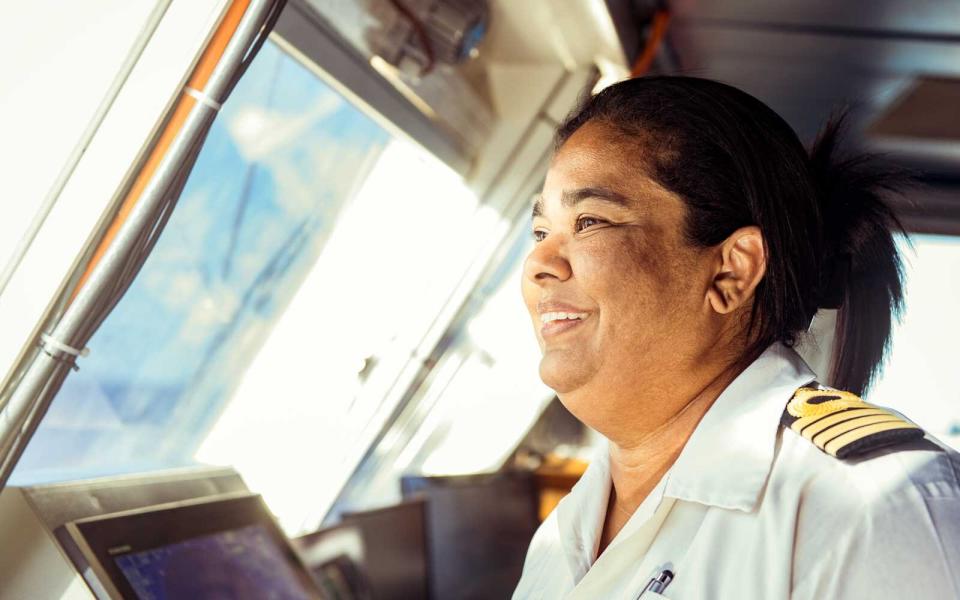
Gabriela Herman Belinda Bennett, captain of the Wind Star.
Our itinerary begins in Panama City. I eavesdrop as passengers introduce themselves. They are from Denver and London and Brooklyn and Carlsbad, California. Many are retirees. Many are seasoned cruisers. One couple from Canada had been on 20 Windstar cruises before this one. Several guests describe the Panama Canal as a bucket-list item.
We jump aboard tour buses and drive from the Pacific coast to the Caribbean port of Colón, at the northern entrance of the canal. The Panama Canal is the country's economic heart, but Colón is a stunning shambles—caved-in apartment buildings, dusty streets, stray dogs. What we are seeing, the guide explains frankly, is the result of gang activity and governmental malfeasance.
On our first day, the Wind Star navigates the canal—one of the Seven Wonders of the Industrial World. I recline in the shade with a James Ellroy book and a steady supply of pi?a coladas. We pass through a set of massive iron doors into the Gatún Locks, the first of the canal's 12 lock structures. The pocked concrete walls, now more than a century old, are the color of earth. I think about the men who left their homes in the Caribbean and dug the canal with nothing more than picks and shovels. How those men survived malaria and yellow fever, predatory jaguars. At times, as many as 40 died each day.
Once the ship is inside the locks, they are flooded. The Wind Star rises to 82 feet above sea level. A pair of gleaming locomotive engines pull the ship into Lago Gatún, south of Colón. Created between 1907 and 1913 by the damming of the Chagres River, the massive man-made lake comprises nearly half of the canal's length. During our daylong crossing, I'm delighted by the surreal experience of passing just yards from gargantuan cargo freighters.
Impressions of the ship: The cabins are compact, about 200 square feet, but smartly laid out and immaculately maintained. The mini-bar situation is tops. (Two words: sparkling rosé!) The food is first-rate; Windstar even has a James Beard Foundation–themed cruise. On a galley tour, I observe plentiful fresh produce, including a mountain of just-chopped onions that I will enjoy that very night in a world-class crock of French onion soup. There's paté and duck breast and lamb and cuts of fish that come with the skin side crisped just so. Soufflé is frequently a dessert option. The bartenders are skilled and game to mix anything from a Papa Doble to a Negroni Sbagliato. There's a spa where I get a 90-minute deep-tissue treatment during which the masseuse rolls out my muscles with a length of hot bamboo. There's a freshwater pool that I find underwhelming, but it doesn't matter since I'm out in the ocean every day. Each afternoon in the lounge there's a full schedule of presentations on such topics as Costa Rican folkloric dancing, pearl formation, gemology, and mixology. Before we arrive in each port, Karla Taylor, a staff naturalist, provides a detailed briefing on the animals we might see during our nature excursion.
Related: Trekking Around Panama
After we've traversed the canal, there's an unexpected wrinkle: 50-mile-an-hour offshore winds force us to cancel a stop on Panama's beautiful, rain-forest-covered Isla Parida. So I spend a day exploring the cathedrals and open-air craft markets of Panama City's Casco Viejo. Old apartment buildings with ornate balconies crowd the narrow streets, as in old European cities. Spring blooms are everywhere. A cabdriver tells me that Panamanians eat iguana. "Yeah, man," he says. "We call it chicken of the tree." I have my first good laugh in a long time. At golden hour I find myself on a promenade overlooking Panama Bay. I snap a photo of the families swimming together.
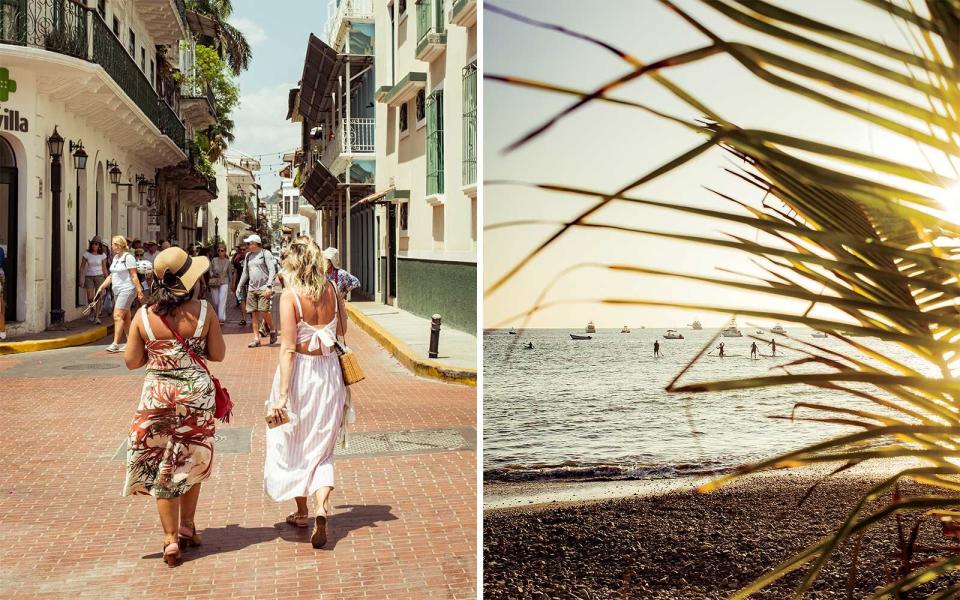
Gabriela Herman From left: Casco Viejo, Panama City's historic district; paddling out in Bahia Herradura.
I'd heard that Panama City was hosting a pretty big Carnival celebration, so the next day I check it out with Gabi Herman, the photographer who traveled with me. The day is hot and the area cordoned off for the celebration is shadeless. On a big stage, women in headdresses dance in unison. The crowd follows their lead. Men perched above the dancers spray water down into the crowd. Gabi and I drink cold, strong beer and walk around for hours, peoplewatching, marveling at the fashion on display in the crowd, the thousands of kids decked out for the party.
The MVP of the Wind Star is Miss Kristi, the destination manager. Each evening over early cocktails, I sit rapt as she introduces the area where we'll be anchoring the next morning. She doesn't turn away from Central America's colonial history or hard truths, like labor struggles on the banana plantations. She tells us everything we need to know about the population, the wildlife, the culture, where to find a taxi if you just want to go check out the town, which beach bars have the best ceviche.
The options for shore excursions are plentiful. You can check out a coca farm or ride an air-tram through Soberanía National Park. Also on the menu are a rum tasting, a monkey-watching excursion, and many marine explorations, including a dolphin watch and a snorkeling adventure around Ca?o Island near Bahía Drake, whose waters are inhabited by triggerfish, sea turtles, trumpet fish, damselfish, and rays. While in Panama City, you can visit the Miraflores Locks or a 600-year-old Embra Indian Village, where the inhabitants still live much as they did before Spanish colonization.
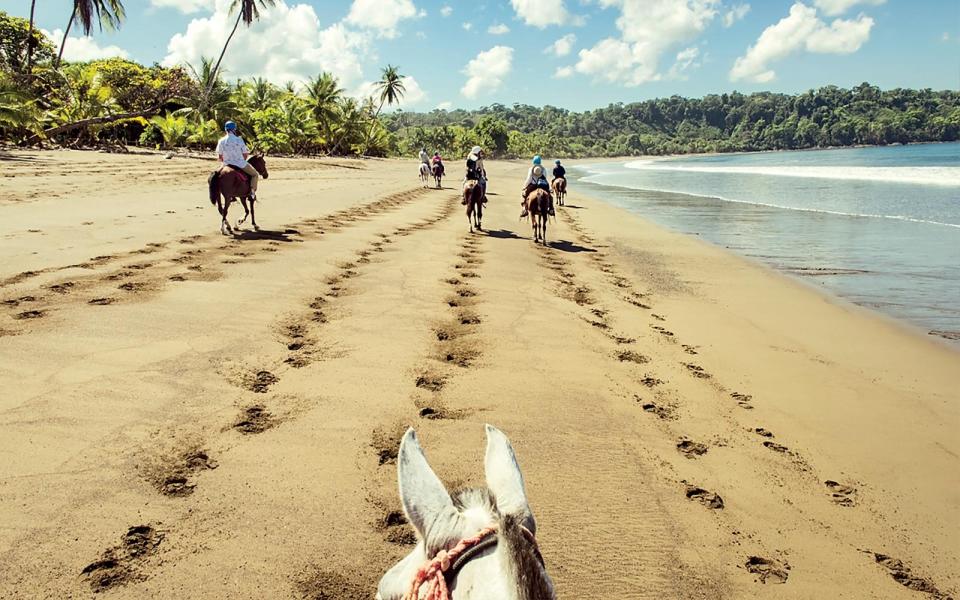
Gabriela Herman A riding excursion while anchored in Bahia Drake, on Costa Rica's central Pacific coast.
And there are experiences you never could have planned for. The day after our kayaking adventure, with the Wind Star anchored in Bahía Drake, a local tour operator picks us up in a 12-person motorboat. We're speeding along when the captain makes an abrupt detour. He has spotted a spout of mist. Moments later we pull up to a pair of humpbacks: a mother and child. We learn about their migration patterns, but all I can focus on is being so close to such immense creatures while in such a small boat.
That afternoon, I hang out at the pool bar, drinking Aperol Spritzes in the sun. Karen, the Brooklynite living in Toronto, is playing backgammon with her husband, Bill. She tells me that when they were teenagers, they had a few "passionate" (her word) summers of camp romance, but lost touch. They both got married and had kids and got divorced. Then, almost a decade ago, she appeared in one of his dreams. The next day, he tracked her down in New York. A few months later, he flew to New York to have lunch with her. A few years after that, she moved to Toronto and they got hitched. They're celebrating their sixth anniversary.
Related: 10 Around-the-world Cruises for the Trip of a Lifetime
At palm-shaded Playa Colorada, we mount horses and ride along the bay. We see a pair of scarlet macaws. We pass sunbathers soaking in a shallow tide pool before turning off the beach and into a meadow of wildflowers. Suddenly, the terrain turns treacherous. My horse, a temperamental lad named Mémo, fights his way up the steep hillside. Mémo's footing seems tenuous. My heart races until we turn onto a level trail that hugs the side of the hill.
The day is idyllic, breezy and clear. Big red butterflies and bright green dragonflies flutter across the trail. We enter Punta Río Claro National Wildlife Refuge. In the forest's shade it feels 10 degrees cooler. Monkeys jump in the trees overhead. The group pushes along slowly, listening.
The next day, with the Wind Star anchored in Quepos, we take a bus to the Titi Canopy Tour, near the entrance of Manuel Antonio National Park, for a high-velocity zipline tour of the forest. I climb onto a platform where I put on a helmet and leather gloves and a heavy-duty waist harness. The morning is cool. The forest is just waking up, the birds starting to sing. I clip onto the overhead cable, recline, and cannonball through the Day-Glo green canopy, 200 feet off the ground. Each leg of the circuit is a quarter of a mile long and fast enough to make me laugh out loud.
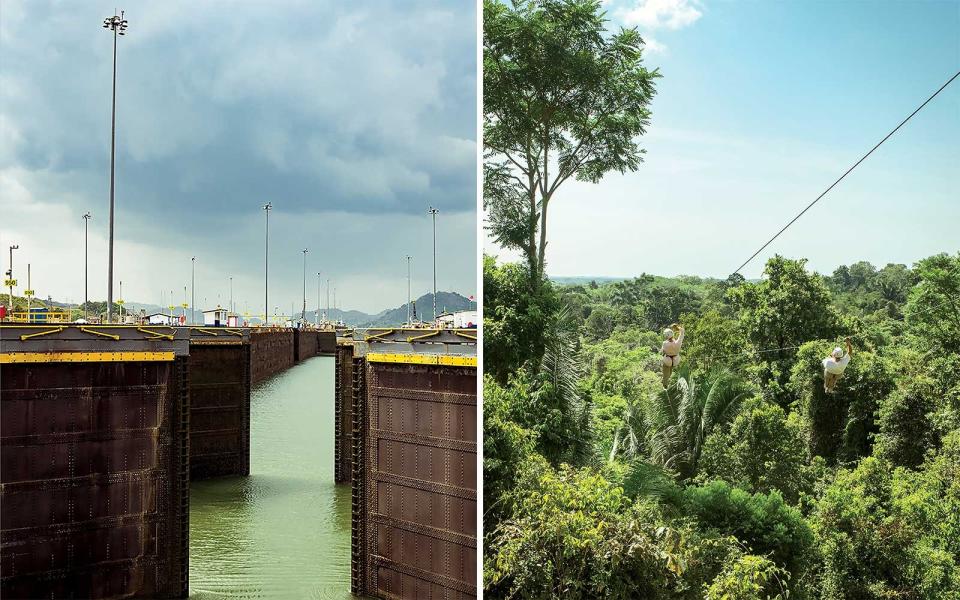
Gabriela Herman From left: Crossing the Panama Canal; the Titi Canopy Tour, in Costa Rica's Manuel Antonio National Park.
I get to talking with a guide in his late twenties named Libé, who has clear eyes and sandy hair. Libé is short for libélula, the Spanish word for dragonfly. He points to the mountains and tells me they are known as the Sons of Saints. All the little towns up there are named after saints—Marcos, Francisco. Libé tells me that he and his wife have a baby and that he has another daughter, who lives with an ex, and that he's trying to be a good man but it's just way harder than you ever imagine it's going to be. One thing he says he does to keep his people close is to bring them into the forest to hike and swim by the waterfalls.
After the canopy tour, I take a cab to Quepos. I find a hole-in-the-wall restaurant on Manuel Antonio Beach and order the casado—a plate of wahoo fish with rice, beans, green salad, and caramelized plantains. I wash it down with two bottles of frosty Imperial lager. Then I go to the beach and bodysurf in the steep waves of the shore break. It's a Sunday, and the beach is crowded with families of Ticos enjoying their day off, swimming and sunbathing and eating overflowing cups of shaved ice. I fall asleep in the shade of an umbrella.
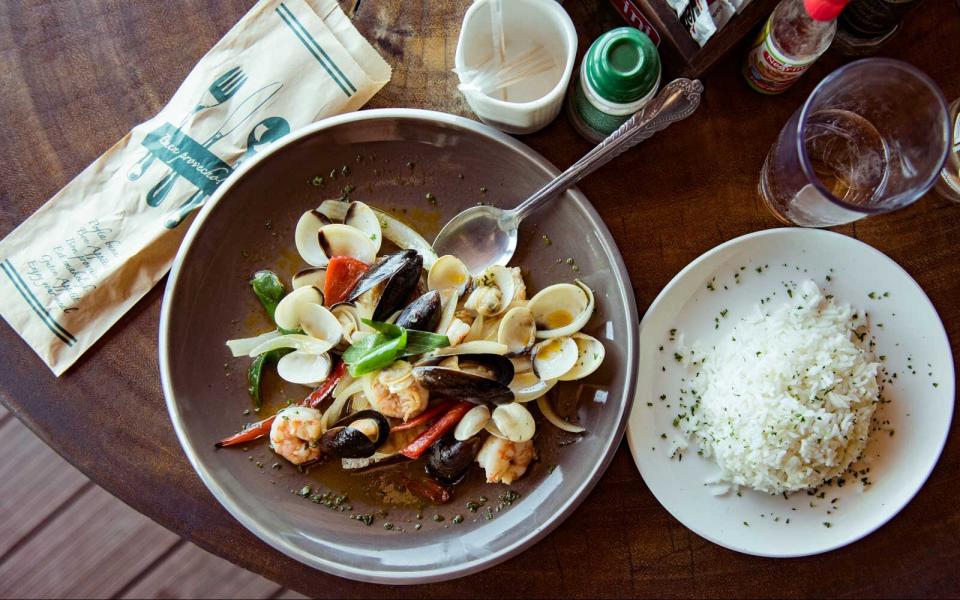
Gabriela Herman The daily special at Marisqueria Corcovado Seafood, in Puerto Jiménez.
In Bahía Herradura, a little bay halfway up the Costa Rican coast, a group of us goes off-roading in fast, four-seat Honda buggies. The objective is to speed over every bump and plow through every mud puddle and stream. Our little convoy kicks up a wicked dust storm as we fly over a dried-up riverbed. I wind up filthy and soaked, my hair coated in gray dust, my clothing brown. I feel great.
That afternoon I unwind at a little beach bar a few hundred yards from where the Wind Star's Zodiacs drop off and pick up passengers. I savor a big plate of ceviche. It's spicy and sweet, with pieces of mango and strawberry. I have a lemonade blended with mint, basil, and ice. The sun is sinking. The horizon is the color of rose. I'm just overflowing with good feelings. I have to run to catch the last tender back to the ship.